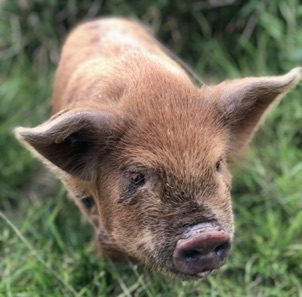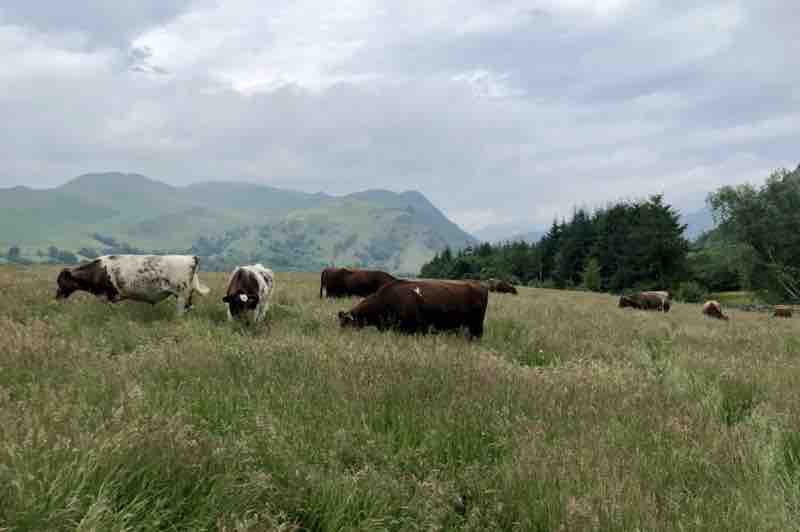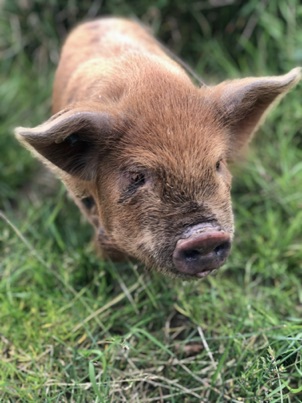
Update from Wilder Gowbarrow
Update from the Wilder Gowbarrow project team.
We promised to report on our successes and failures as we tread gently forward with the Wilder Gowbarrow project at Gowbarrow Hall Farm Ullswater. It’s our belief that all that happens – good and bad – is simply feedback, and that’s fueling our next ever more informed decisions.
The family at Gowbarrow hall farm are working with Wilderculture CIC to implement a ‘Wilderculture approach’ – a strategy developed in response to the question; ‘how do we use regenerative agriculture in an upland setting?’ and ‘how can we rewild areas of land but still produce nutrient dense food and an income for the farm?’.
Wilderculture challenges the widely promoted concept that the uplands are so unproductive that they should be rewilded instead of farmed. We wanted to demonstrate that simply removing livestock isn’t necessarily optimal for either biodiversity or nutrition security long term. It is also important our cultural farming heritage is considered.
Removing livestock production from the uplands is simply shifting the food production problem to somewhere else in the world. The plant foods required to replace the nutritional value of the meat produced is generally grown from farming systems that degrade the soil and reduce biodiversity – often by pioneering virgin forests. As we are all part of one atmosphere with shared seas we don’t feel this is a truly sustainable plan!
However the modern version of upland farming isn’t working that well!

We have seen all-time low levels of profitability, highly concerning biodiversity loss, an increase in flood and drought events and a significant and costly rise in livestock and human health issues.
We believe many of these issues can be attributed to a loss of soil health and ecological complexity within our farmed environment and we seek to increase profitability and resistance by reversing those trends.
At Wilder Gowbarrow we are aiming – within the next three to four years – of becoming self-reliant in terms of feed and fertility. Farm profitability can often be restored if the costly inputs of fertiliser, vet med costs, hay/silage making and machinery costs can be removed – that’s our plan.
We have developed a grazing plan designed to rapidly rebuild the depleted soil health and help transition the livestock to an outwintering system that relies upon stockpiled standing forage instead of hay and environmentally and economically costly imported cereal feeds.
We hope to run a profitable food production system from just sunshine and rainfall, whilst increasing biodiversity and sequestering carbon from the atmosphere into stable structure in the soil.
For the first couple of years of transition this will require a reduction in livestock numbers to allow the long recovery periods and tall grass required to ‘sheet compost’ the depleted inbye land to quickly rebuild carbon and revitalise the soil organisms required to generate abundant nutrients for the entire food web.
The decision to reduce livestock numbers in the short term – particularly the sheep – was made easier by the fact that when subsidies are removed from the equation those conventional enterprises are more often than not, loss making.
Whilst the livestock are paddock grazing the inbye the winter grazing area is resting and stockpiling forage so we can avoid having to use fertilisers or to cut hay – money saved, photosynthesis increased. Energy flow (photosynthesis is one of the limiting factors in both production and biodiversity so this is a key feature of our approach.
Our first winter was a useful trial and it went well. The herd of shorthorn cattle have, on the whole, fared better than expected without housing and on minimal supplemented feed. We are optimistic that this winter, following a full summer of planned paddock grazing the increasingly adapted cattle will do even better. Sam and Claire will be continually selecting for the livestock that do best on the system to ensure we are optimising the genetics of the herd.
We are also adopting a free choice mineral supplementation program that we hope will help to remineralise areas of land and support the health and disease resistance of the herd.
The soil health in the fields that were paddock grazed last summer has already improved to an impressive degree and we are seeing a number of new plant and insect species appearing on the farm.
As the land, plants, and livestock get healthier, the farm can gradually increase its carrying capacity to an optimal point where it is profitable and productive without the costly inputs.
The aim long term is to get back to somewhere near the original carrying capacity of the farm with minimal costs. Although we have removed the sheep for the shorterm to help with the transition, there’s no guarantee that an adapted grass fed flock won’t feature in the future.
Even on poor soil health with newly adapted cattle we are seeing daily growth rates of over 2kg a day on some of the young stock – comparable with many grain finished systems.
The sale of 100% grass fed organic meat will be a great help to farm profitability and we hope the farm’s future will be far more resilient in the face of climate change and unpredictable payment schemes.
We are working with Libby Robinson who has provided four gorgeous fell ponies for the project. The ponies grazing behaviour and dung will be beneficial to areas of the farm and further increase the diversity of our management impact.
The most recent new arrivals are the Wilder Gowbarrow wild boar. Well not really! Instead of terrifying hairy hunters, Sam and Claire decided on the more family friendly and exceptionally cute Kune Kune pigs. Having arrived from a highly domesticated setting where they liked to get a tummy scratch they have adapted surprisingly well to rooting and foraging on acorns roaming loose within the hundreds of acres of woodland and wood pasture that forms the winter block. Ecologically they are doing a great job of roughing up areas to let new seeds have a chance to germinate in the otherwise dense sward.

We will keep you updated on progress and take a look at www.wilderculture.com for open days and training offerings in our approach.


No Comments